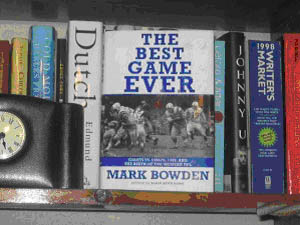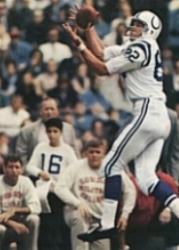The Best Game Ever: A Book Review

The Best Game Ever has a special place in the reviewer's library.
“Early in the third quarter, the Giants had their backs to the wall, just as they had all season. They were an established NFL power in America’s greatest city, with a lineup of star athletes expected to dominate the league for years to come…”
So writes Mark Bowen, author of The Best Game Ever. With an eye for detail and a flair for stating the dramatic in a sufficiently understated way so as to make it more dramatic, Bowden weaves the story of the game many still say is the greatest ever played.
The 1958 NFL championship game at Yankee Stadium between the New York Giants and the Baltimore Colts was a game for the ages. It would be the first nationally televised NFL championship game. It would pit, as Bowden aptly points out, the league’s stingiest defense (the Giants) against the league’s most powerful offense (the Colts). It would become the first NFL game to go to sudden death overtime…and it would officially awaken the consciousness of a nation to the sport that had long labored under the long shadow of major league baseball. Today, no sport is more widely followed by American sports fans. No league is more wildly successful and lucrative.
This was not the case in 1958.
In 1958, the great postwar boom was still in full stride, but some new and discordant notes had sounded…Just over the horizon was a decade of restless social, political, and cultural upheaval, but none of that was obvious yet. Americans had never been more affluent, and had never had more leisure. And pro football, which was about to catch hold, would just shoulder on through all this coming change, growing ever more popular and ever more rich.
The names involved in this championship game alone make it singular. Baltimore players sported name like John Unitas, Raymond Berry, Alan Ameche, Art Donovan, Lenny Moore, “Big Daddy” Lipscomb, and Gino Marchetti. The Giants fielded giants, as well. Their players included Frank Gifford, Sam Huff, Rosey Grier, and Pat Summerall. The Colts were led by now legendary coach Weeb Ewbank, who would become the only man to win both the NFL and AFL championships as a head coach. Flanking Giants’ head coach Jim Lee Howell were offensive coordinator Vince Lombardi and defensive coordinator Tom Landry.
It was the greatest concentration of football talent ever assembled for a single game. On the field and roaming the sidelines, including Giants owners Wellington and Jack Mara, were seventeen future members of the NFL Hall of Fame.
The game itself was a masterpiece, but the stories surrounding the game were also the stuff of legend. From the wit and humor of the gregarious Art Donovan to the meticulous – obsessive, even – work habits of Raymond Berry and John Unitas, Bowden opens the curtains to the behind-the-scenes action and drama leading up to, surrounding, and following the great game.
The chapter on Raymond Berry depicts the story of achievement in the face of odds and athletic accomplishment despite physical limitations, the likes of which would never be written as a work of fiction because it would be considered entirely too fanciful. Writes Bowden:
The story of Raymond Berry is more than the story of an overlooked, talent-deprived young athlete who by dint of sheer effort, will, and dedication turns himself into a star. There are players who fit that description on every team…His personality and his obsessions changed not only his own life, but those of his teammates and the Colts’ organization, and ultimately the history of pro football.

Raymond Berry
The other stories and back stories are equally important and receive attention from Bowden’s keen eye and sharp pen. He doesn’t overlook the influence of the father of modern football, Paul Brown, on the game. He doesn’t miss the unlikely way the Colts got hold of the man who would become forever the gold standard for pro quarterbacks, John Unitas. He highlights the genius of Lombardi and Landry. He reveals the chess game that played out on the field between the defensive guru Landry, his star linebacker Sam Huff, and Unitas.
Adding to the book’s appeal are odd insertions of the stories of random fans who were watching the game. People whose names may have never appeared in a published work before and may never after give color and clarity to the meaning and magnitude of this game. Consider Ed Chaney, Jr…
At Henry Mack’s pub on Ritchie Highway in Glen Burnie, Maryland, Ed Chaney, Jr., one of about three dozen Colts’ fans watching on TV, called his boss at a nearby service station to say he would be late for work. The boss fired him. Chaney hung up happily and ordered another beer.
We may debate which is the greatest pro football game ever played, as my Dad would say, until the cows come home. But any honest debate, even a half century after the fact, must include the 1958 NFL championship game between the Baltimore Colts and the New York Giants. For people like me who were born after the fact – I would not enter the world until 1961 and would not develop a fully functional pro football consciousness until about 1970 – this book brings to life the game that changed the game forever, and the men who made it what it was.
The Best Game Ever may not be the greatest sports book ever. But for a true fan of the NFL, for a fan who wants to look beneath the glitz and glamor of today’s game and understand its roots, this book is a must read.
And it’s a good read, which makes it all the better.
All quotations for this article are taken from the book: The Best Game Ever by Mark Bowden ©2008 by Mark Bowden
I visited many sites but the audio quality for audio songs existing at
this web page is really marvelous.
my blog post – BIG SMITH 【ビッグスミス】